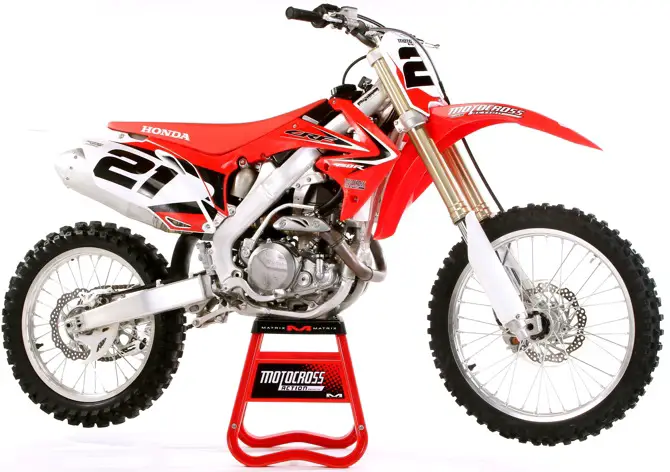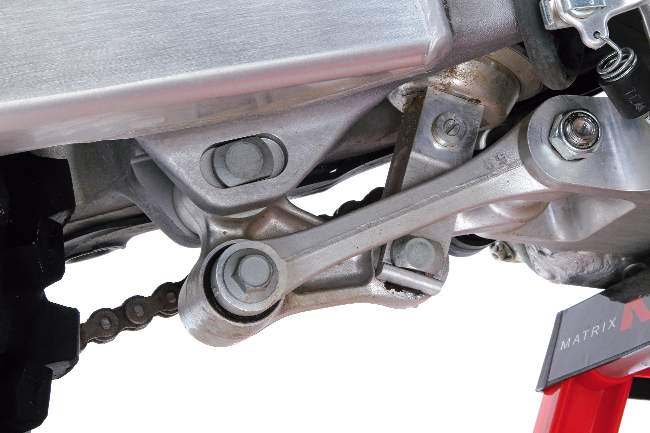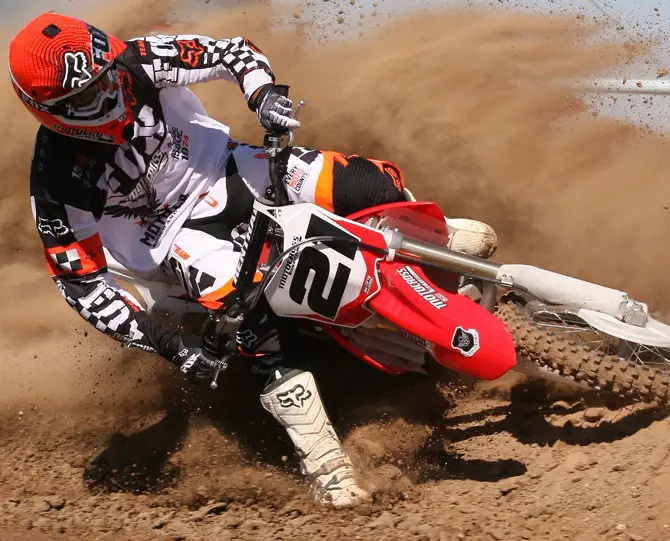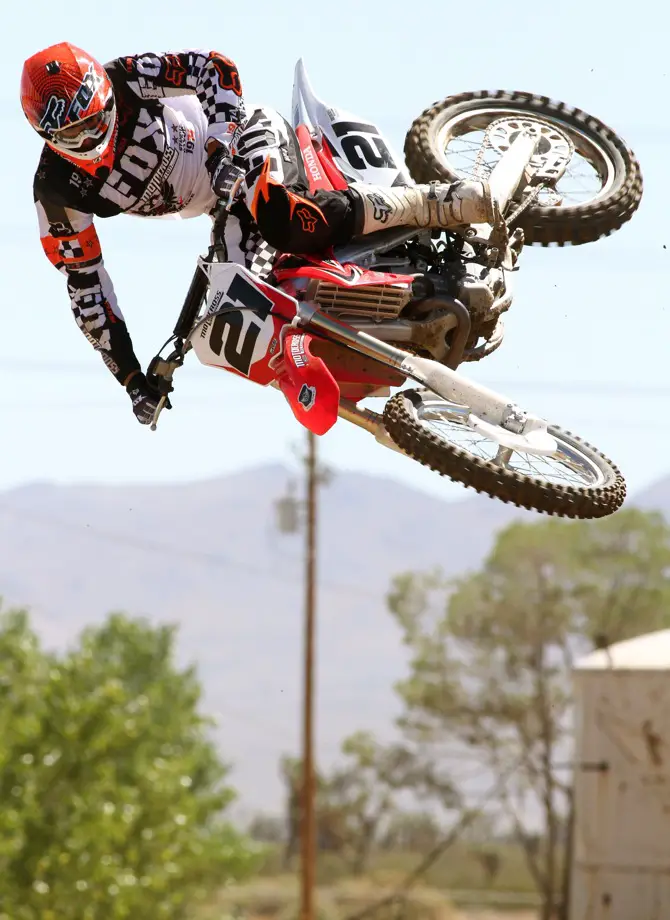MXA’S 2012 HONDA CRF450 MOTOCROSS TEST: THEY HIRED NEW TEST RIDERS FOR 2012

Q: FIRST AND FOREMOST, IS THE 2012 CRF450 BETTER THAN THE 2011 CRF450?
A: Yes. As the two bikes sit on the showroom floor, the 2012 model has three features that make it a better all-around motocross machine.
Q: WHAT ARE THE THREE CHANGES THAT HONDA MADE TO THE 2012 CRF450?
A: Before we talk about the three major changes for 2012, let’s rehash all the changes that Honda has made to the new-generation CRF450 since its introduction in 2009.
(1) Maps . The 2010 CRF450 got a new program that produced a gentler and less barky powerband. Plus, the programmer module was made more accessible (on the 2009 model, you had to remove the gas tank to reprogram the engine).
(2) Compression release. Because of high-profile failures with the 2009 automatic compression release, the 2010 model got new pin and weight shapes.
(3) Fork seals. The 2010 forks got a higher oil height, more low-speed compression damping and longer-lasting seals.
(4) Shock. In 2010, the valving was softened to make the shock more supple over small bumps.
(5) Throttle body. For 2011, the jumbo-sized 50mm throttle body from 2009 and 2010 was reduced to 46mm in an attempt to improve low-end power and lessen the tendency to flame out.
(6) Shock linkage. On the 2011 CRF450, Honda completely replaced the shock linkage and bell crank to stiffen the rising rate. Most test riders thought this was a step in the wrong direction, or, at best, a step in no discernible direction.
(7) Steering damper. For 2011, the HPSD steering damper’s body diameter was increased from 20mm to 24mm.
(8) Muffler. The 2011 muffler is 100mm longer and got a smaller 26mm core instead of 2010’s 36mm core.
(9) EFI map. Ignition and fuel maps were changed in 2011 to work with the restrictive muffler and downsized throttle body.
 Punch: The CRF450 engine produces a mellow and easy to use style of power that makes it easy to ride. There is none of that rushing around like on more powerful bikes. |
Q: WE REPEAT, WHAT ARE THE THREE CHANGES THAT HONDA MADE TO THE 2012 CRF450?
A: Here are the three areas that Honda focused on for the 2012 model year.
(1) Forks. The 2012 Kayaba forks have stiffer fork springs (after 10 years of local and National racers changing the springs to aftermarket springs). Given that fork springs run around $100 (with another $100 labor charge to change them), this mod is a $200 value.
(2) Shock linkage. There is another all-new shock linkage for 2012. This is the third rising-rate change in the four-year history of this version of the CRF450. Additionally, the chain roller has been changed to work with the new swingarm angle. Given that virtually every serious CRF450 racer changes to an aftermarket shock linkage, this mod has a $225 value.
(3) Footpegs. Honda has had the worst footpegs of any production motocross bike. Not only were the previous CRF450 footpegs narrow and short, but they were easily clogged with mud because they offered minimum draft through the pegs. For 2012, the CRF450 gets all-new footpegs?which are wider and longer. For CRF450 riders who bought aftermarket pegs, the 2012 Honda pegs are a $100 value.
Q: WHAT IS THE EFFECT OF THE THREE CHANGES HONDA MADE FOR 2012?
A: The MXA wrecking crew does not believe that motocross bikes need to be totally redesigned every model year. That was de rigueur during the flush economic years of the past, but in today’s challenging market, ground-up redesigns are not only too expensive for consumers but reckless for the bottom line of the manufacturers. We think that the basic bike can stay and the modifications can be limited to the problem areas. However, that doesn’t mean manufacturers should not release new products or that they can just sell last year’s bike without improvements. Au contraire!
The manufacturers have a fiduciary responsibility to provide their customers with the best product possible for the dollar. If their bike has an obvious flaw, that flaw should be fixed. In essence, that is what Honda tried to do in 2012. Rather than make a lot of meaningless changes, as they did in 2010 and 2011, Honda’s engineers took a close look at what their loyal buyers did to the CRF450 after buying it. Then, they made those changes on the production line to be more in sync with their customers.
Q: DID HONDA ADDRESS ALL OF THEIR PREVIOUS FLAWS FOR 2012?
A: Glory be, no! Here is MXA‘s list of things that we would like them to address.
(1) Four-spring clutch. When is a clutch not a clutch? When it has four springs and lasts about four minutes in the hands of a clutch abuser. Last year, Honda’s engineers put jutter springs behind the CRF450 clutch to preload the clutch pack. MXA test riders took the jutter springs and small friction plate out and replaced them with an additional full-size clutch plate. If we had our druthers, we’d return to the six-spring clutch from the 2008 CRF450. Instead, we install a six-spring Hinson clutch, which adds $750 to the cost of a race-ready CRF450.
(2) Top-end power. Fuel injection has been a brave new world for motocross designers. There is no doubt that EFI offers trouble-free jetting and an increase in low-to-mid throttle response. The problem is that it kills top-end power, at least on most 450s. Need proof? The 2008 Honda CRF450, with its 41mm Keihin FCR carb, produced more horsepower from 8000 rpm to 10,000 rpm than the 2009, 2010, 2011 or 2012 CRF450. As a rule, the EFI-equipped CRF450s are flat on top. They make terrific power off the bottom, but once they reach 8600 rpm, the power goes flat. It doesn’t climb, and it doesn’t fall; it hangs all the way to sign-off.
(3) Brake disc guards. Most MXA test riders remove the front disc guard, and some remove both the front and back guards. Why? There was a time when Honda brakes were the industry leaders. Not anymore. The Brembo-equipped European bikes, with their 260mm and 270mm front rotors, blow the CRF450 stoppers out of the water. Additionally, when used hard, the CRF450’s Nissin units fade fast. Among the solutions to Honda’s brake issues, along with oversize rotor kits and special brake fluids, is the simple option of removing the air-blocking disc guards. With the disc guard removed, the rotor and caliper run cooler and last longer. Yes, we know that the front disc guard is a value-added part that only Honda offers, but what good is a value-added part that lessens performance? Honda could save the money to use on some more important upgrade.

2012 Honda CRF450: Without gilding the lily, the 2012 Honda CRF450 is essentially the 2011 model with three changes. To Honda’s credit the three changes do improve the overall performance of the bike.
Q: WHAT RACE MODS DOES MXA MAKE…THAT WE DON’T EXPECT HONDA TO MAKE FOR US?
A: On a race-by-race basis, the MXA wrecking crew tries lots of products, mods and ideas. Here are the ones we recommend:
Fuel filter. Over the course of a race season, a lot of dirt gravitates into the gas tank. Some of it is from debris in the bottom of your gas can, and some is from when you have the gas cap off in the pits. This dirt eventually makes it to the fuel pump’s filter, which can, in extreme cases, clog the filter and stop the engine (rarely at an opportune moment). MXA runs Splitstream fuel filters in our gas tanks. This simple and easy-to-use sock-like filter fits in the gas-tank opening and stops dirt clogs from getting to your fuel pump or injector nozzles. For more information, go to www.split-stream.com or call (503) 830-6433.
Flywheel weight. The CRF450 responds well to heavier flywheel weights. We use a 17-ounce Steahly flywheel weight to torque up the bottom end and carry the existing power farther into the top end. For more information, go to www.steahlyoffroad.com.
Tires. For 2012, Honda has switched to Dunlop MX51 tires front and rear. Most MXA test riders like the rear MX51 (in a 110 size, not the 120 that Honda specs), but we prefer to run the Dunlop MX31 front tire for intermediate terrain.
Hour meter. Because of the Honda’s dual oil chambers, it needs oil changes more often than the YZ, KX, RM or KTM. With only 650cc of oil in the engine, an hour meter is the best way to keep track of the time between oil changes. For more information on hour meters, go to www.dubachracing.com or www.worksconnection.com.
Clutch springs. If you can’t afford a full Hinson six-spring clutch, we recommend installing stiffer clutch springs. These are available from Hinson, Barnett and Pro Circuit.
Gearing. As a rule of thumb, Novice and Vet riders added one tooth (13/49), while Intermediate and Pro-level riders went for 14/52 gearing (this is lower than stock, but not as low as 13/49).
Skid plate. To protect the engine cases and water pump, we run the same carbon fiber skid plate that Kevin Windham uses on his Geico Honda CRF450. It retails for $199.95 from www.lightspeedcarbon.net.
Exhaust system. The Honda CRF450 loves aftermarket exhaust systems…to the tune of 2-1/2 horsepower at peak and a broader powerband from idle to sign-off. We never met an aftermarket pipe that didn’t make the CRF450 run better, and we have tested Pro Circuit, FMF, Yoshimura, DR.D and Vance & Hines pipes.
Radiator cap. The CRF450 runs hot. The cheapest and easiest solution is to swap out the stock 1.1 kg/cm2 radiator cap for a 1.6, 1.8 or 2.0.

Rise: Taking a cue from local racers and the aftermarket, the 2012 linkage lowers the rear by 5mm and softens the curve.
Q: IS THE 2012 HONDA CRF450 FASTER THAN THE 2011 CRF450?
A: No. Honda made no changes to the engine, mapping, exhaust or throttle body for 2012. The 2012 engine is the 2011 engine.
Q: HOW FAST IS THE 2012 HONDA CRF450?
A: Given that it wasn’t very fast in 2011, it is not very fast in 2012. That said, the CRF450 engine is very tractable, well modulated and pleasant to ride. It produces what one MXA test rider referred to as a “no-hit, no-rush, no-hurry” style of power. Because it revs predictably, the powerband is quite usable and is well suited to the typical local motocross racer.
Q: WHAT IS THE BIGGEST FLAW OF THE 2012 CRF450 POWERBAND?
A: It’s flat on top?very flat. It makes very good power from 5000 rpm all the way to 8600 rpm. Then, the power stops climbing. It makes the same amount of power at 8000 rpm as it does at 9000 rpm, as it does at 10,000 rpm, as it does at 11,000 rpm. There might be a scenario where a flat powerband would be a plus, but we can’t think of one.
Q: HOW DOES THE 2012 CRF450 RUN ON THE DYNO?
A: The Honda CRF450 isn’t going to win any dyno shootouts with its power output. The 2012 CRF450 pumped out 52.59 horsepower. That is the least of any of the Big Five 450s and almost three horsepower less than the 2012 KX450F.
Q: WHAT DOES THE 2012 CRF450 POWERBAND FEEL LIKE ON THE TRACK?
A: All is not lost with the stock CRF450 powerband. It is still a capable motocross weapon?if used properly. As a rule of thumb, flat powerbands work best when short-shifted. In the case of the 2012 CRF450, that means shifting just short of peak. No big deal, because peak on the CRF450 is in the right spot. If you don’t shift at peak and persist in revving the engine?and it will rev for an extra 3000 rpm?you will not be rewarded with forward thrust, because there is no torque or thrust to be gained by going past 8600 rpm. Revving the engine will produce more noise, but not more power.
Test riders said that the powerband was “mellow.” They didn’t mean that as a criticism as much as an apt description. Since the hit was muted and the power electric, the CRF450 was less jerky and violent than bikes with big horsepower numbers. It could be ridden harder because it rewarded aggressiveness with a hooked-up feel instead of a wheelie and a swap. The 2012 Honda CRF450 power was manageable in the corners, which translated into greater exit speed. And that exit speed could more than make up for any horsepower deficit on the straights. The same held true on all but the longest starts. It got out of the gate with very little drama and, if shifted at peak, could hold its own into the first turn.
Q: HOW DOES THE 2012 CRF450 HANDLE?
A: It’s no secret that the MXA wrecking crew has issues with the frame geometry on the 2009?2012 Honda CRF450s. We understand Honda’s desire to try something different, be on the cutting-edge and attempt to leapfrog over the rest of the 450 pack, but there is such a thing as being too different.
In a nutshell, the CRF450 has a strangely configured chassis that exhibits oversteer to the nth degree. The tendency of the front end to tuck under at turn-in, understeer from center-out and require countersteering on the exit of the turn is disconcerting. Thankfully, savvy CRF450 tuners can iron some of this out with three simple setup tricks. What are those tricks?
(1) Balance. To calm down the CRF450 chassis, the front and rear of the bike need to be brought into balance. The quickest way to achieve this is to stiffen the forks so they can complement the relatively stiff CRF rear suspension. As you may have noted, one of Honda’s changes for 2012 was stiffer fork springs. This was a good idea.
(2) Stinkbug. When Honda designed the chassis for the 2009?2012 CRF450s, they went the stinkbug route?down in the front and up in the rear. Most savvy CRF450 riders use a two-prong attack on this setup. First, they stiffen the forks to hold the front end higher in its stroke. Second, they install a longer rising-rate linkage to lower the rear of the bike. Although the linkage may seem like a suspension mod, it was really a handling mod. As you might have noted, another of Honda’s 2012 changes was a new rising-rate linkage (bell crank and pull rods). The result is a slightly softer feel to the shock and a lower rear end. Good stuff
(3) Oversteer. From a handling point of view, oversteer is not necessarily a bad thing. It is required to some degree to set the action of cornering into motion, but too much oversteer results in a lot of wagging at the handlebars to get the bike to hold a selected line. The Band-Aid for oversteer is to slide the forks up and down in the triple clamps to find the correct head angle for the existing track conditions. With stiffer fork springs and a lower rear end, the rider can reconfigure the frame geometry himself.

Grab handles: Not a great handling machine, the 2012 Honda CRF450 is improved over its 2009 through 2011 brethren (thanks to stiffer fork springs and a better balanced chassis).
Q: HAS HONDA FIXED THE HANDLING ON THE 2012 CRF450?
A: That depends on what your definition of fixed is. If you mean fixed as in “made perfect,” then no. If by fixed you mean ameliorated some of the problems, then yes. It should be noted that MXA expects a totally new Honda CRF450 for 2013?which could be the fix we have been looking for since the glory days of the 2008 CRF450.
Q: WHAT WAS OUR BEST FORK SETTING?
A: We have to give kudos to Honda’s engineers for doing what we asked them to do 10 years ago, by finally putting stiffer fork springs in the Kayaba forks; Honda has saved buyers of the 2012 CRF450 untold dollars. Okay, it took them 10 years to do it, but let’s not dwell on the past. The 2012 forks get a 0.49 kg/mm set of springs to replace the previous 0.46 springs. Additionally, the chromed fork legs have been beefed up to lessen flex in the corners, and the oil height has been raised 10cc.
For hardcore racing, these are MXA‘s recommended 2012 Honda CRF450 fork settings:
Spring rate: 0.49 kg/mm
Oil height: 365cc
Compression: 12 clicks out
Rebound: 9 clicks out
Fork leg height: Flush with clamps
Notes: With the stiffer fork springs, the bike rides higher into corners, doesn’t dive as much, which lessens oversteer, and stays in better balance. Don’t be afraid to move the forks up and down in the clamps to alter the head angle to achieve the steering response you want.

The 2012 CRF450 is the lightest 450 made. It is 7 pounds under the YZ450F, 11 pounds under the KX450F, 12 pounds under the 450SXF and 13 pounds under the RM-Z450.
Q: WHAT WAS OUR BEST SHOCK SETTING?
A: The 2012 CRF450 shock is unchanged from 2011, but it works differently because it is attached to a totally new rising-rate linkage. The new rising rate, achieved by a reconfigured bell crank and pull rods, is softer across the board than last year’s all-new bell crank and pull rods, which were stiffer across the board than the 2010 rising-rate system. The 2012 setup is closer to the 2010 curve than the 2011 rate. On the plus side, the new link lowers the rear of the bike by 5mm.
For hardcore racing, these are MXA‘s recommended 2012 CRF450 shock settings:
Spring rate: 5.4 kg/mm
Race sag: 105mm
Hi-compression: 1 turn out (1-1/2 stock)
Lo-compression: 12 clicks out
Rebound: 13 clicks out
Notes: Is this the end of aftermarket CRF450 links? Probably not, since longer pull rods could easily lower the rear an additional 5mm, which would allow for more handling options.
Q: WHAT IS THE WORST PART ON THE 2012 HONDA CRF450?
A: The clutch is a joke. If you don’t have any money, remove the two jutter springs and the small inner-diameter friction plate and put one normal CRF450 clutch plate in its place. This will increase the surface area and return the 2012 clutch back to 2010 specs. If you have $50, put in stiffer clutch springs. These help keep the clutch alive, but can’t do much for the CRF450’s very short engagement throw. If you are bucks-up, put Hinson on your speed dial and order a six-spring clutch. Even with that bucks-up mod, the clutch actuation arm’s short throw will still be a bug-a-boo.
Q: WHAT DID WE HATE?
A: The hate list:
(1) Clutch. What clutch?
(2) Graphics. There is nothing more depressing than rolling a brand-new $8440 bike out of the showroom only to have people think that it is a one- or two-year-old bike. How can you tell a 2012 CRF450 from a 2011 CRF? The 2012 has silver footpegs and the 2011 has black footpegs.
(3) Gearing. We don’t think the low-to-mid powerband is in sync with the gearbox ratios.
(4) Brakes. Lose the disc guards front and rear. They don’t help the average-at-best front brake fight off fade from overheating.

The old pegs can now be used on vintage bikes…where they belonged.
Q: WHAT DID WE LIKE?
A: The like list:
(1) Footpegs. The new pegs are wider and don’t clog with mud.
(2) Sound. With a super-long muffler and a 26mm core, the CRF450 is very quiet, but all that restriction is what killed the powerband’s personality.
(3) Weight. MXA‘s 2012 CRF450 hit the scales at 231 pounds (without gas). For comparison, the 2012 YZ450F weighed 238 pounds, the KX450F 242 pounds, the KTM 450SXF 243 pounds and the Suzuki RM-Z450 244 pounds. That 10 pounds plus was noticeable, and most test riders felt that the light weight of the CRF450 was one of its best features.
(4) Linkage. Hurray for Honda. They may have just copied what local racers have been doing, but at least they were smart enough to copy a good idea.
(5) HPSD. If ever a bike needed a steering damper, the over-caffeinated CRF450 is it.
Q: WHAT DO WE REALLY THINK?
A: We think that Honda did the right things?or at least three out the four things it needed to do?for 2012. Maybe in 2013 they will put the 2008 clutch back in. We congratulate Honda on an intelligent R&D job for 2012. Instead of trying to reinvent the wheel, they turned to local racers to see what they had been doing to their CRF450s and copied them. That’s a smart way to make your bike better without breaking the bank. This is a better CRF450..not great, but better. Take a bow, because you were one of the Honda R&D riders this year.





Comments are closed.